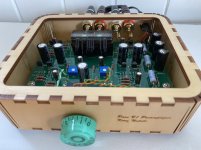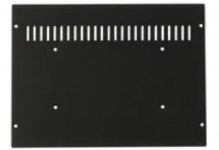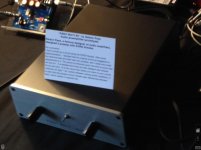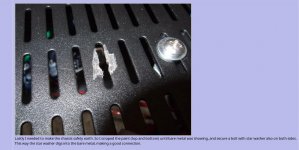I just tried with both boards suspended in the air and are held only by the wires.... changing volume still rings, which is completely baffling... perhaps the wires connecting the PCB's are causing the vibration.
I'll try sound damping material both on the relays and on the tube, and some anti-vibration washers or standoffs.
FWIW, if I tap one of the filter caps lightly with a screwdriver, I'll get ringing that lasts 10-15 seconds. Perhaps mine is bad?
So far relays seem like a bad idea, but I really love this solution as its remote controlled and the display is cool.
I'll try sound damping material both on the relays and on the tube, and some anti-vibration washers or standoffs.
FWIW, if I tap one of the filter caps lightly with a screwdriver, I'll get ringing that lasts 10-15 seconds. Perhaps mine is bad?
So far relays seem like a bad idea, but I really love this solution as its remote controlled and the display is cool.
Open chassis box = ringing high pitch sound from time to time
Closed box = music only = no more microphonic phenomena
From my experience 🙂 Good luck!
Closed box = music only = no more microphonic phenomena
From my experience 🙂 Good luck!
OK..
Both boards suspended in air, putty on the Nutube and on relay strip, zip tie tightly the input wires to eachother and close cover.....
Very faint ringing. Its still there, but much less.. so some progress
Both boards suspended in air, putty on the Nutube and on relay strip, zip tie tightly the input wires to eachother and close cover.....
Very faint ringing. Its still there, but much less.. so some progress
Open chassis box = ringing high pitch sound from time to time
Closed box = music only = no more microphonic phenomena
From my experience 🙂 Good luck!
I will agree with this statement, including the good luck part.
I have a perforated lid on my case and even that seems to have curtailed the self-started ringing. The bottom chassis without lid was horrendous. I mounted my standoffs on rubber washers and did a bunch of experimenting to see if they helped more between board/standoffs or standoffs/case... and washers everywhere. In truth, I am not sure that the rubber washers are doing a ton. If I tap my case the tube still rings, just less (I think). Tapping the tube will get a ring no matter what, oddly it usually doesn't sustain though.
The real issue was the self started ringing. That would sustain and keep increasing; I became a believer in the Mythbusters' earthquake machine. Again, the lid on seems to have helped with this issue, though I haven't been playing music loud. If I clap, Lurch always appears and I pray that he goes away. My build has a definite downside, as it's a hybrid power amplifier--no matter what volume I have the music at, the ringing is full volume.
My plan is to purchase the Nutube accessory kit and a new Nutube. It's going to be a nightmare to solder the board in place, but the socket is vital in my opinion. The plastic enclosure of tube will help as well. Until I can snag the kit, I'll just pray the ringing stays minimal.
Normally PCB 4 corners are connected to chassis by metal standoff so box it's grounded as well.
What if get back to situation from Your first photo but try closed chassis hermeticaly from all sides ?

What if get back to situation from Your first photo but try closed chassis hermeticaly from all sides ?

..I have a perforated lid on my case and even that seems to have curtailed the self-started ringing. The bottom chassis without lid was horrendous. I mounted my standoffs on rubber washers..
Do You try take rubber washers away and make connection of pcb ground to the chassis with the 4 metal standoff's ?
More quiet now ?
Do You try take rubber washers away and make connection of pcb ground to the chassis with the 4 metal standoff's ?
More quiet now ?
No. It has not been a perfect control experiment for me. I have not tried it with zero rubber washers, except when I had the lid off. I will, but the rubber has not made the difference I thought it would. Like others, I'm sure, we initially tested with lid off to be able to tinker. The lid on made a difference. Natural frequency something or other.
It positively is not a grounding issue or a ground loop, if that is what you are getting at. I've tested various grounding. Simply, the tube is microphonic. That was my last suspicion, but it seems to be the case. If I clap inside the room... the ringing starts, and I hope it stops.
FWIW, if I tap one of the filter caps lightly with a screwdriver, I'll get ringing that lasts 10-15 seconds. Perhaps mine is bad?
Out of six NuTubes I have built into various projects, I only had one that rang as badly as you describe. But it was in a Millett NuClassD power amplifier and increasing the NFB slightly solved the problem. That is not an option with the B1Korg. I tried adding NFB to the B1K and it ruins the sound that the circuit is so famous for.
If you bought your tube from the DIYaudio store, perhaps you could check with Jason and he will exchange it under warranty?
Do Your chassis is gray painted? Probably ground's are not connected together?It positively is not a grounding issue or a ground loop, if that is what you are getting at. I've tested various grounding..
Only metal standoff's with metal screws and washers can connect the PCB ground path to the chassis
without painting, so we need "naked" metal to "naked" metal physical and electrical contact's.
Top cover with chassis bottom included (metal with metal)
Rubber with rubber, painting with painting don't work IMHO.
Your top cover style is great for class A power amplifier heat dissipation
but for B1K pre is way too much open & airy ( bunch of holes ) so not protect agains microphony.
Anyways great DIY work! Fantastic build!
Best regards

Simply, the tube is microphonic. That was my last suspicion, but it seems to be the case. If I clap inside the room... the ringing starts, and I hope it stops.
Hi Patrick, my Nutube was microphonic too, but I almost solved this issue placing, even without the aim of any kind of adhesive tape, two big flat rubber pencil erasers, one stacked upon the other, directly ON the glass surface of the Nutube. Before this trick, simply clapping my hands triggered the ringing (the same that you hear when you speak into a microphone and you stand very close to the loudspeaker). Now, with the closed chassis,I can hear a week and short ringing only if I scrape heavily the upper cover. I'm confident that if I dampen the inner walls of the chassis, I will get better results. But for now it's enough.
Gaetano.
..I'll try sound damping material both on the relays and on the tube, and some anti-vibration washers or standoffs..
Any work in progress news ?
Use of vibrations damping material for relays and Nutube triode ( component only ) is a good idea
but B1K pcb need to be tighty connected with 4 metal standoffs, metal screws, metal washers ( without rubber or plastic )
to " naked " metal of the chassis box so ground path is OK.
Papa example preamp is always closed , two mono volume potentiometers.
Work like a charm source: B1 with Korg Triode
Attachments
Mine is not grounded (using plastic standoffs on PCB).
It is not noisy or anything but I am using a linear PSU. Is connecting the ground to chassis mandatory?
It is not noisy or anything but I am using a linear PSU. Is connecting the ground to chassis mandatory?
Any work in progress news ?
Use of vibrations damping material for relays and Nutube triode ( component only ) is a good idea
but B1K pcb need to be tighty connected with 4 metal standoffs, metal screws, metal washers ( without rubber or plastic )
to " naked " metal of the chassis box so ground path is OK.
Papa example preamp is always closed , two mono volume potentiometers.
Work like a charm source: B1 with Korg Triode
I'm still experimenting... I've ordered various types of dampening sheets to apply to the chassis covers, and to the relay strip and Nutube.
I also ordered some of those isolating standoffs Roo2 mentioned.
I can't fully close the chassis yet as I don't have panels, and a volumee display is held with zip ties to the frame which prevents closing the lid entirely.
I placed an order for front and rear panels for my chassis and external PSU, once I get those I will finalize the wiring and test with it fully closed.
The various methods I've used help reduce the ringing with volume change, I'm hoping the stuff that is on the way will eliminate it.
A loud clap can cause ringing, but I'm assuming that will be resolved once I'm able to totally close it.
Before ordering panels from FPE (I really like my projects to be aesthetically pleasing), I wanted to listen to this before investing further $$ into it. With my recently built F5 into PMC 87db standmounts, this is some of the best sound I've heard in my room.. definitely a keeper.
Regarding grounding, why do you need all 4 washers.. shouldn't a single connection be sufficient?
Right now, I only have one standoff that is fully metal-metal that is grounding the PCB to the case, the others are with rubber grommets for vibration control.
If I want to use the Whammy headphone amp with the B1 Korg, and use 2 pots - one 50K pot for B1 Korg and the other for the Whammy, do I need to: (i) use a buffer before the two pots; or (ii) add a switch after the input selector to direct the source to either the B1 or the Whammy? I am concerned that the loading of the Whammy pot in parallel with the input to the B1 Korg will throw off the B1 Kong's input, as I understand that the 50K input pot speed for the B1 Korg is critical.
50k isn't critical for the B1, as the NuTube is buffered on the input and the output.
I'm not sure how you are going to hook it up... Can you expand a bit?
I'm not sure how you are going to hook it up... Can you expand a bit?
50k isn't critical for the B1, as the NuTube is buffered on the input and the output.
I'm not sure how you are going to hook it up... Can you expand a bit?
Yes:
Inputs to source selector switch; then to both: (i) a 50K pot (actually, I will be using a TubeCAD S3 attenuator so I can avoid the pot slider and have integrated balance control) for the B1 Korg, which will then connect to the B1 Korg at the designated PCB pot connection points; and (ii) 20K pot for Whammy, which then will connect to Whammy at the designated PCB pot connection points.
I'm sure I read something that said the 50K pot was somehow critical to the proper functioning of the B1 Korg. Perhaps I am wrong. In which case, the lower impedance due to the paralleled pots should not be a problem (assuming the source can drive both pots). Some concern about this is why I would either switch the source to either the B1 Korg or the Whammy or use a buffer.
I fired up my B1 for the first time and want to confirm the voltages. I'm using a regulated linear supply (AMB s11), and the output from that is 23.97V. The output on the s11 is determined by a Zener diode and a ratio of 2 resistors, so the tolerance of those 3 components will determine the end-result voltage.
With this, everything is pretty much up to spec except T3 which I have 22.44V.
Now, this does seem very marginal, but the guide says that values should fall within 0.5V, and in this case I'm slightly out of spec. I think the build is fine as all other test points are exact.
Would you leave this as-is, or perhaps try a slightly lower value resistor on the CRC to drop less voltage?
So something weird is going on... earlier, besides T3 being on the slightly low side, all the other voltages were spot on.
I haven't changed anything on the board itself, and now I have quite a few deviations.
First, it seems like my mains flucuates a bit, since now my PSU is outputting slightly more than before, a steady 24.11V.
T3 now measures withing spec at 22.7V.
BUT, T4 is now 11V (it was around 9.2V), which has a cascading effect that T6 and T5 are 0.9V.
T7 and T8 went down to 6.2V, they were at 9.6V beforehand.
Any ideas how this could have suddenly changed?
- Home
- Amplifiers
- Pass Labs
- B1 with Korg Triode



